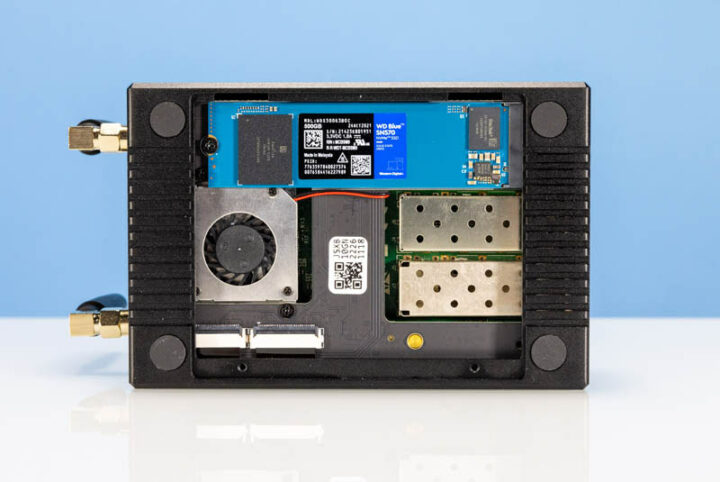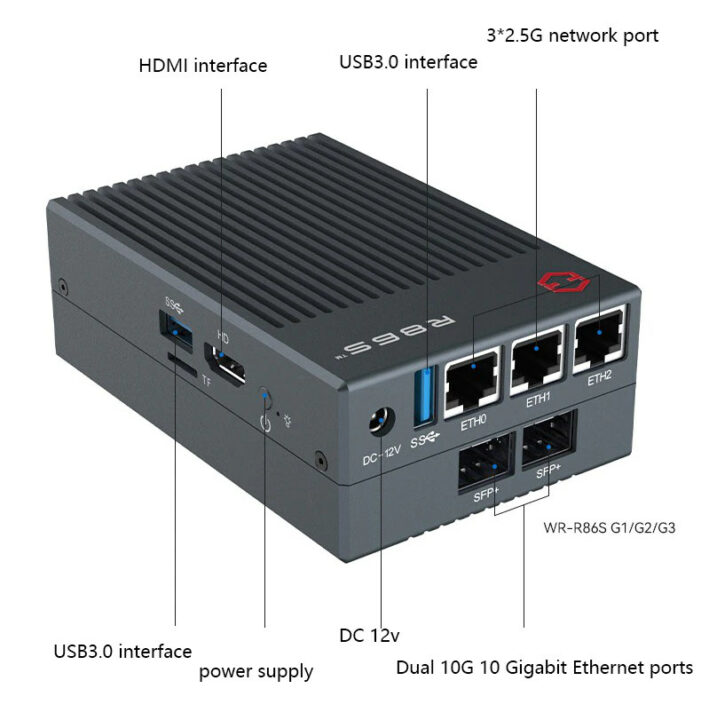Gowin R86S (aka GW-R86S) is an affordable Intel Celeron N5100 or Pentium N6005 Jasper Lake mini PC, router, and firewall appliance with 2.5GbE and 10GbE networking that sells for $310 and up on Aliexpress.
10GbE used to be reserved for the enterprise market due to the cost of hardware, but costs have gone down a lot as illustrated by the Gowin R86S system with up to three 2.5GbE ports, two 10GbE SFP+ cages, as well as ports that you would typically find a mini PC such as HDMI 2.0 video output, M.2 socket for NVMe SSD, two USB 3.0 ports, and a WiFi module.
Gowin R86S specifications:
- SoC (one or the other)
- Intel Celeron N5105 quad-core Jasper Lake processor @ 2.0GHz / 2.9GHz (Turbo) with Intel UHD graphics 605; 10W TDP
- Intel Pentium N6005 quad-core Jasper Lake processor @ 2.0GHz / 3.3GHz (Turbo) with Intel UHD graphics @ up to 900 MHz; 10W TDP
- System Memory – 8GB or 16GB DDR4-2933
- Storage – 128GB eMMC flash, M.2 socket for NVMe SSD, MicroSD card socket
- Video Output – 1x HDMI 2.0 port
- Networking
- 3x 2.5GbE RJ45 ports via Intel i225-V controllers
- R86S G-Series only – 2x 10GbE SFP+ cages through an NVIDIA-Mellanox ConnectX-3 dual 10GbE OCP NIC 2.0 card
- R86S P1 & P2 – M.2 2230 WiFi and Bluetooth? module
- R86S G3 – Intel AX201 WiFi 6 & Bluetooth 5.2 module soldered on mainboard plus two external antennas
- USB – 2x USB 3.0 ports
- Misc – Power button
- Power Supply – 12V via DC jack
- Dimensions & Weight
- R86S P-Series – 119 x 79 x 27.5 mm | 360 grams
- R86S G-Series – 119 x 79 x 41 mm | 460 grams

The system comes pre-loaded with OpenWrt, but the company also lists Linux, Windows, Ubuntu, Proxmox, CentOS, and pfSense operating systems. Five SKUs are available with the G-Series adding SFP+ cages which are missing in the P-Series models:
- GW-R86S P1 – Celeron N5105 with 8GB RAM, WiFi module
- GW-R86S P1 – Celeron N5105 with 16GB RAM, WiFi module
- GW-R86S G1 – Celeron N5105 with 8GB RAM, no wireless module
- GW-R86S G2 – Celeron N5105 with 16GB RAM, no wireless module
- GW-R86S G3 – Pentium N6005 with 16GB RAM, Intel AX201 WiFi 6 & Bluetooth 5.2 module
We found out about the Gowin R86S through ServeTheHome where Patrick Kennedy reviewed the GW-R58S G3 model with OpenWrt, pfSense, OPNsense, Ubuntu, Proxmox VE, Windows, and VMware ESXi 8. The network performance, tested with iperf3, was great just as advertised with the throughput maximized at 2.5Gbps and 10 Gbps speeds, but it is worth noting that the SFP+ cages don’t seem to work at 2.5 and 5Gbps, so only 1Gbps and 10 Gbps are supported. Overall, Patrick was really happy about the device, barely larger than a Raspberry Pi 4 mini PC, with downsides including mostly the fan noise and the Intel Pentium N6005 may become a bottleneck for some workloads. People who prefer video reviews will find one embedded below.
While the Gowin GW-R86S G1 sells for about $310 with a Celeron N5105 SoC and 8GB RAM, the top model (GW-R86S G3) tested by STH above with a Pentium N6005, 16GB RAM, and an AX201 WiFi 6 module goes for $455 including shipping (but not taxes for our European friends).

Jean-Luc started CNX Software in 2010 as a part-time endeavor, before quitting his job as a software engineering manager, and starting to write daily news, and reviews full time later in 2011.
Support CNX Software! Donate via cryptocurrencies, become a Patron on Patreon, or purchase goods on Amazon or Aliexpress





